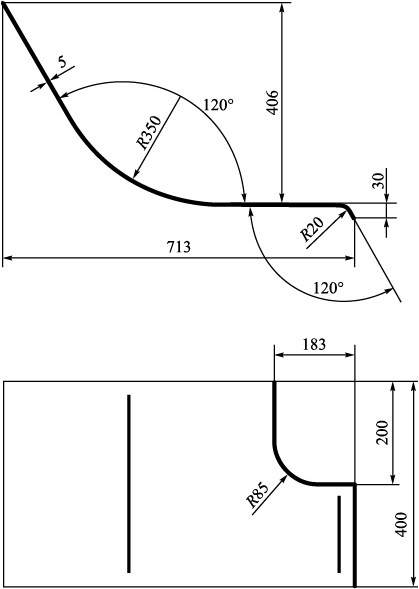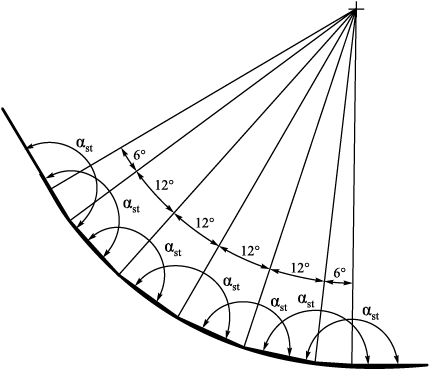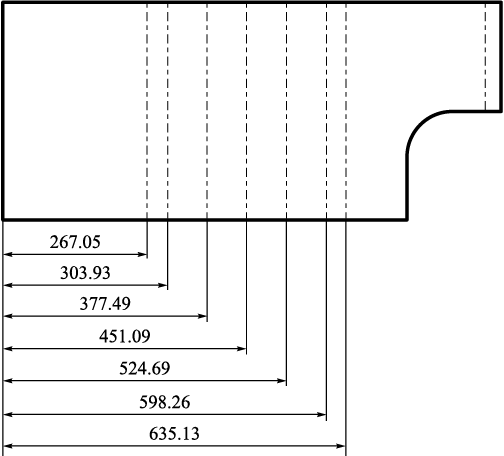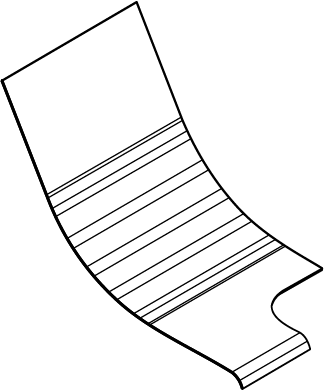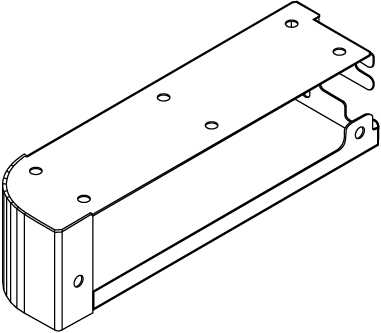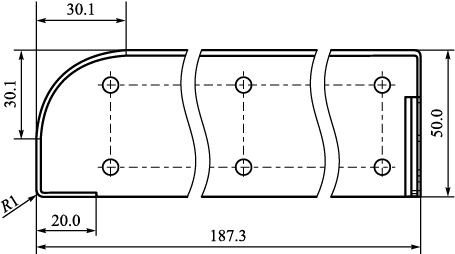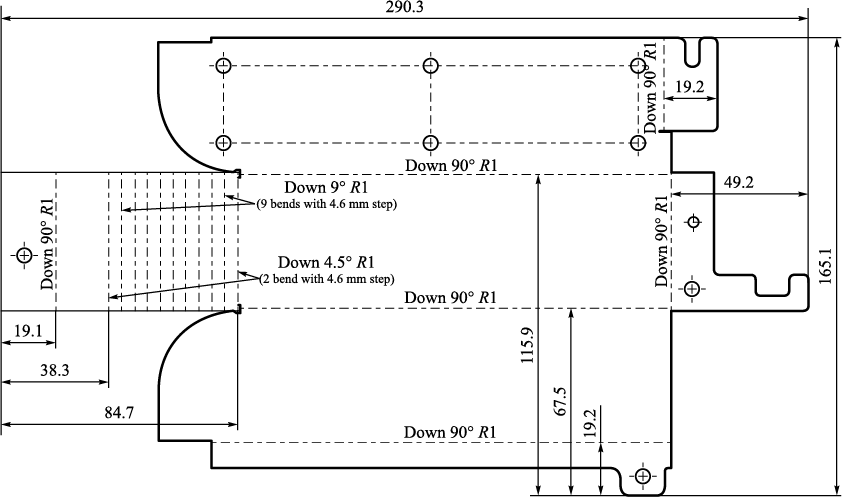Scroll to:
Production of arc sheet elements by stepped bending method
https://doi.org/10.17073/0368-0797-2025-3-233-238
Abstract
The article considers the issues of obtaining thin-walled parts with arc-shaped elements for small devices and units in small-scale or single production using the principles of prototyping, which has recently been widely used to test and evaluate ideas at the earliest stage of development, and in some cases, to verify the functioning of a prototype device. Taking into account the requirements for the parts quality, the technology of stepped bending is chosen, which uses a set of consecutive V-shaped bends to obtain a given curvature of the billet. The basic principle of the multi-stage forming process is to replace the bending arc with a polygon, each side of which is a rectilinear section of sheet material of a given length, while bending the sheet metal using a small-radius punch. The accuracy of forming an arc segment using polylines depends on their number. The greater the number of bending steps, the smoother the profile is formed, but the bending process becomes more laborious and technically complex. Therefore, the technical and economic indicators of the process depend on correct choice of the number of steps. With this bending method, it is difficult to avoid a prismatic structure on the billet surface; in this case, the traces of step bends will be more noticeable on the inside of the bent sheet material compared to the outside. Using stepped bending technology, various metal parts of the prototype of the universal plasma low-temperature sterilizer of Plaster Med TeCo series were manufactured, which allows fast, safe and effective sterilization of a wide range of medical equipment. As an example, the use of stepped bending technology of a stainless steel sheet billet for the production of a thin-walled bumper for a sterilizer door is considered.
Keywords
For citations:
Karfidov A.O., Chichenev N.A., Vasil’ev M.V., Chicheneva O.N. Production of arc sheet elements by stepped bending method. Izvestiya. Ferrous Metallurgy. 2025;68(3):233-238. https://doi.org/10.17073/0368-0797-2025-3-233-238
Introduction
Arc-shaped billets are a common type of sheet metal parts used in the fabrication of housings for various devices and products [1 – 3]. These billets feature variable geometries, and their processing is often more complex than that of conventional billets. In practice, two main forming methods are typically employed to manufacture billets with arc-shaped elements [4 – 6].
• Single-stage forming using a die and punch with profiles that match the required billet configuration. This method is generally applied to billets with complex shapes. Its advantages include high forming accuracy, a smooth and even billet surface, and the absence of surface defects. However, the cost of press tooling is relatively high, and its versatility is limited, making it most suitable for large-scale production. This approach is usually chosen when a single-stage process is required or when the surface quality of the billet is subject to stringent requirements.
• Multi-stage forming (stepped bending), which is based on approximating the arc by a series of straight-line segments. These segments can be formed using standard tools and equipment. The key advantage of this method lies in its flexibility: there is no need to manufacture custom dies and punches for each specific design. As a result, the production cost of billets is lower, and a high level of forming quality is achieved.
This article presents a stepped bending technology for forming the bending radius in thin-walled sheet metal parts and demonstrates its application in the fabrication of a specific arc-shaped billet.
Problem statement
The basic principle of the multi-stage forming process is to approximate the bending arc with a polygon, each side of which corresponds to a rectilinear section of sheet material of a given length (Fig. 1). In this method, bending is performed using a small-radius punch.
Fig. 1. Formation of bending radius of sheet material |
The accuracy of forming an arc segment using polylines clearly depends on the number of bending steps: the greater the number, the smoother the resulting profile. However, this also increases the labor intensity and technical complexity of the process. As a result, the technical and economic performance of the process depends on the correct choice of the number of steps. With this bending method, it is difficult to avoid a prismatic surface structure on the billet. It should also be noted that traces of stepped bends tend to be more pronounced on the inner side of the bent sheet metal than on the outer side.
Conducted research
Reference1 examines the procedure for approximating a circular arc with polylines and calculating the bending angles of the segments, using as an example the steel part shown in Fig. 2. This part has an internal arc radius of R = 350 mm, a bending angle of αbend = 120°, and a plate thickness of s = 5 mm. Since the conditions for using the billet correspond to the characteristics of the multi-stage forming method, stepped bending was applied for its fabrication. Based on previous forming experience and the available forming tools, a punch with a tip radius of r = 120 mm.
Fig. 2. Example of a part for segmentation of arc-shaped bend |
To implement the multi-stage forming process, the curved segment (an arc with radius R = 350 mm) was divided into six segments (steps) represented by polylines. Practical experience in fabricating similar parts has shown that to achieve a smoother transition from the arc to the straight portion of the billet (i.e., at the ends of the curved segment), it is advisable to set the end step angles to half the value of the central segment angles. As shown in Fig. 3, the billet illustrated in Fig. 2 is formed by seven bending operations. The end (first and second) bend angles, corresponding to one step αst , are 6°, while the remaining (central) bend angles are 12°. The total bending angle across all segments (steps) is approximately αst ≈ 170°.
Fig. 3. Segmentation of arc-shape bend of polylines (7 bends) |
An expanded view of the deformable billet with indication of bending lines is shown in Fig. 4, and its axonometric image is presented in Fig. 5.
Fig. 4. Expanded view of the deformable billet with indication of bending lines
Fig. 5. Axonometric image of the deformable billet |
Plasma-based technologies are widely used for sterilizing products in various sectors of the national economy, including medicine, pharmaceuticals, veterinary care, cosmetology, and the food industry. These technologies are valued for their versatility, enabling the sterilization of a wide range of items and materials [7 – 9]. In practical applications, the most common type of sterilizer uses an ionized gas as the active agent, generated under low pressure – so-called low-temperature plasma. Hydrogen peroxide is typically used as the sterilizing agent. It is introduced into the working vacuum chamber, where it acts on the treated items, disrupting the vital activity of microorganisms. Low-temperature plasma has virtually no adverse effect on structural materials, making it suitable for sterilizing products made from various materials, including metals, plastics, and textiles. Plasma technologies are particularly effective for sterilizing materials sensitive to high temperature and humidity, as well as instruments and devices with special coatings or painted surfaces [10 – 12].
Using stepped bending technology, various thin-walled parts were fabricated for a prototype of the universal low-temperature plasma sterilizer of the Plaster Med TeCo2. As an example of the application of stepped bending, this section considers the fabrication of an arc-shaped segment of the sterilizer door bumper. The axonometric image of the bumper is shown in Fig. 6, and its longitudinal section in Fig. 7. The final forming quality of the billet in this process depends on the number of bends and the spacing between them: the more steps used, the smoother the resulting surface. Given the hygienic requirements for the sterilizer, the bumper billet was made from 1 mm thick stainless steel grade 12Kh18N10T (GOST 5949–75).
Fig. 6. Axonometric image of the sterilizer door bumper
Fig. 7. Продольный разрез чертежа бампера двери стерилизатора, |
Previous studies [13 – 15] provide formulas for calculating the bending angle of each step, as well as the deviation between the resulting stepped polyline profile and the target arc-shaped (circular) profile. Based on dimensionless (relative) parameters, a formula was derived for determining the step bending angle as a function of punch displacement. This forms the basis for selecting the number of bends needed to meet the technical requirements for the part’s profile. It has been shown that for parts whose external dimensions must meet quality grade h12 (GOST 25346–2013), the number of steps should be Zst ≥ 10; for quality grade h14 – Zst ≥ 6.
In the present case, a slightly conservative value of Zst = 10, was selected, resulting in a bending angle per step of αst = 9°. As noted earlier, to ensure a smooth transition from the arc to the rectilinear section of the billet (i.e., at the beginning and end of the arc-shaped segment), it is advisable to make the step angle in these regions half the angle of the central segments. Thus, at the end sections, the bending angle per step was set to αst = 4.5°. An expanded view of the deformed bumper billet with indication of bending lines is presented in Fig. 8.
Fig. 8. Expanded view of the deformable billet of the sterilizer door bumper |
Conclusions
The study addressed the fabrication of thin-walled parts with arc-shaped elements for small-scale or single production of devices and instruments using stepped bending technology, which involves a series of consecutive V-shaped bends to achieve the specified bending radius of the billet. Using this technology, various thin-walled parts were fabricated for a prototype of the universal low-temperature plasma sterilizer of the Plaster Med TeCo series. The practical application of this method was demonstrated using the example of forming an arc-shaped segment for the sterilizer door bumper.
References
1. Kargin V.R., Kargin B.V. Theory of Metal Forming: Manual. Samara: Samara University; 2019:112.
2. Burdukovskii V.G. Sheet Stamping Technology: Manual. Yekaterinburg: UrFU; 2019:224.
3. Multiscale Modeling in Sheet Metal Forming. Banabic D. ed. Heidelberg: Springer; 2016:405.
4. Yakovlev S.S. Forging and Stamping. In 4 vols. Vol. 4. Sheet Stamping. Moscow: Mashinostroenie; 2010:732.
5. Konstantinov I.L., Sidel’nikov S.B. Forging and Stamping Production: Textbook. Moscow: INFRA-M; 2021:464.
6. Benson S. Bending Basics. Cincinnati: Fabricators & Manufacturers Association; 2017:581.
7. Salmanov A.G., Verner O.M. Sterilization of Medical Devices. Kharkiv: FOP Panov A.M.; 2015:412.
8. Card A.J., Ward J., Clarkson P.J. Successful risk assessment may not always lead to successful risk control: A systematic literature review of risk control after root cause analysis. Journal of Healthcare Risk Management. 2012;31(3):6–12. https://doi.org/10.1002/jhrm.20090
9. Johna S., Tang T., Saidy M. Patient safety in surgical residency: Root cause analysis and the surgical morbidity and mortality conference – case series from clinical practice. The Permanente Journal. 2012;16(1):67–69. https://doi.org/10.7812/TPP/11-097
10. Satahira K., Nakasone K. Sterilization effects of HO2/O2- radicals produced by H2O-O2 plasma. Journal of Photopolymer Science and Technology. 2016;29(3):433–438. https://doi.org/10.2494/photopolymer.29.433
11. Usta E.O., Ayaz F. Gas plasma hydrogen peroxide (H2O2 ) sterilization. 3rd Advanced Engineering Days. 2012;3:54–56.
12. Sarangapani C., Patange A., Bourke P., Keener K., Cullen P. Recent advances in the application of cold plasma technology in foods. Annual Review of Food Science and Technology. 2018;9:609–629. https://doi.org/10.1146/annurev-food-030117-012517
13. Vasil’ev M.V., Karfidov A.O., Svinarev M.D., Chichenev N.A. Prototyping technology for step-by-step bending of thin-walled enclosures. Stal’. 2022;(7):27–29. (In Russ.).
14. Chichenev N.A., Karfidov A.O., Vasil’ev M.V., Chicheneva O.N. Determination of parameters for step-by-step bending of thin sheet metal. Chernye metally. 2024;(1): 17–20. (In Russ.). https://doi.org/10.17580/chm.2024.01.03
15. Karfidov A.O., Chichenev N.A., Vasil’ev M.V., Chicheneva O.N. Prototyping of stepped bending of sheet metal for manufacture of thin-walled enclosures. In: Modern Technologies and Reverse Engineering: Proceedings of the All-Rus. Sci. and Pract. Conf. Sevastopol: SevSU; 2023:220–222. (In Russ.).
About the Authors
A. O. KarfidovRussian Federation
Aleksei O. Karfidov, Head of the Chair “Engineering of Technological Equipment”
4 Leninskii Ave., Moscow 119049, Russian Federation
N. A. Chichenev
Russian Federation
Nikolai A. Chichenev, Dr. Sci. (Eng.), Prof. of the Chair “Engineering of Technological Equipment”
4 Leninskii Ave., Moscow 119049, Russian Federation
M. V. Vasil’ev
Russian Federation
Mikhail V. Vasil’ev, Senior Lecturer of the Chair “Engineering of Technological Equipment”
4 Leninskii Ave., Moscow 119049, Russian Federation
O. N. Chicheneva
Russian Federation
Ol’ga N. Chicheneva, Cand. Sci. (Eng.), Assist. Prof.
4 Leninskii Ave., Moscow 119049, Russian Federation
Review
For citations:
Karfidov A.O., Chichenev N.A., Vasil’ev M.V., Chicheneva O.N. Production of arc sheet elements by stepped bending method. Izvestiya. Ferrous Metallurgy. 2025;68(3):233-238. https://doi.org/10.17073/0368-0797-2025-3-233-238




